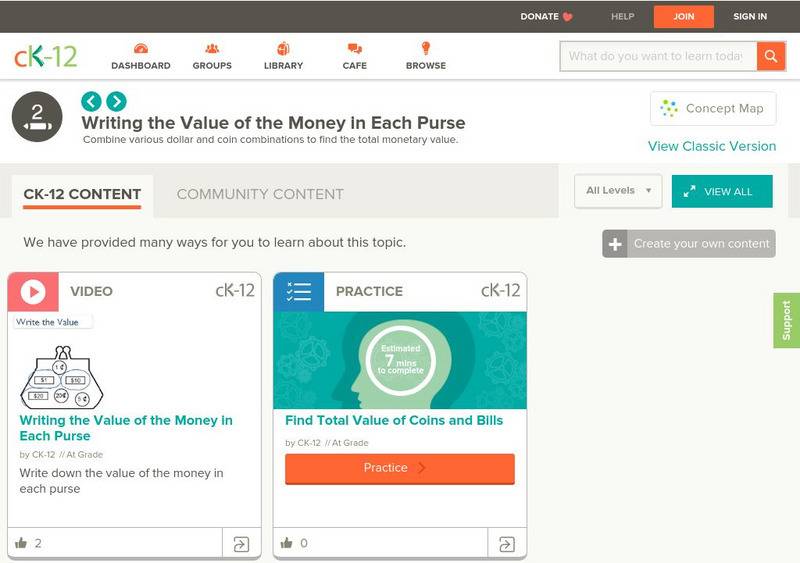Curated OER
All About Money
Few topics engage young mathematicians as much as learning about money. Through a series of shared readings and hands-on activities, children explore the US currency system, learning how to count money and calculate change as they create...
Illustrative Mathematics
Money in the Piggy Bank
It's time to crack open that piggy bank and see what's inside. First, count up the pennies, nickels, dimes, and quarters, identifying what fraction of them are dimes. Then calculate the total value of the coins, writing another fraction...
Math Moves U
Collecting and Working with Data
Add to your collection of math resources with this extensive series of data analysis worksheets. Whether your teaching how to use frequency tables and tally charts to collect and organize data, or introducing young...
US Mint
Coin Connections
Help young mathematicians make cents out of the US currency system with this two-part math lesson. Children first learn the names and values for each type of coin, before learning to count and compare the values of coins using the...
Busy Teacher’s Café
"Smart" by Shel Silverstein
Find out just how smart your young mathematicians are with this cross-curricular math and language arts lesson. After first reading Shel Silverstein's poem "Smart", students draw pictures of coins to model the different exchanges...
Math Salamanders Ltd.
Counting Quarters, Dimes, Nickels, and Pennies Sheet 2
In this counting coins instructional activity, students count up the quarters, dimes, nickels, and pennies in each problem. Students complete seven problems.
Math Salamanders Ltd.
Counting Quarters, Dimes, Nickels and Pennies Sheet 1
In this counting quarters, dimes, nickels, and pennies sheet, learners match the coins to the amounts shown. There are seven problems.
Curated OER
Susan's Choice
Young economists explore opportunity cost by counting how much money Susan has in her piggy bank. From here, they are challenged to help Susan make a choice about what she can buy with her money.
Raytheon
Data Analysis and Interpretation
For this data analysis and interpretation worksheet, learners use charts, graphs, statistics to solve 42 pages of problems with answer key included.
Raytheon
Permutations and Combinations
For this permutations and combinations worksheet, students complete word problems and pattern problems dealing with permutations and combinations. Students complete 14 problems total.
Concord Consortium
Vending Machine
Let the resource quench your thirst for knowledge, like a vending machine that dispenses drinks. Future computer scientists develop an algorithm to identify the fewest number of coins that a vending machine could use in creating change....
Expansion Learning
Expansion Learning: Math Activity: Counting Quarters and Dimes
Activity provides students the practice they need to master the skill of counting quarters and dimes. Immediate feedback is given.
CK-12 Foundation
Ck 12: Elem Math: Finding the Equal Amount of Money Given
[Free Registration/Login may be required to access all resource tools.] This interactive resource is practice problems where students complete the table to determine how you would make a given amount of money using dimes, nickels,...
ABCya
Ab Cya: Learning Coins
Explore a tutorial to learning facts about the coins and their value then play a game to sort the coins by value.
Expansion Learning
Expansion Learning: Math Activity: Counting Quarters, Dimes, Nickels and Pennies
Activity provides students the practice they need to master the skill of counting quarters, dimes, nickels, and pennies. Immediate feedback is given.
Expansion Learning
Expansion Learning: Math Activity: What Coin Is This?
Activity provides students the practice they need to master the skill of identifying coins. Immediate feedback is given.
CK-12 Foundation
Ck 12: Elem Math: Finding the Total Monetary Value
[Free Registration/Login may be required to access all resource tools.] The video describes how to find a monetary value given a specific amount of quarters, dimes, and nickels where students have to multiply each coin amount and then...













